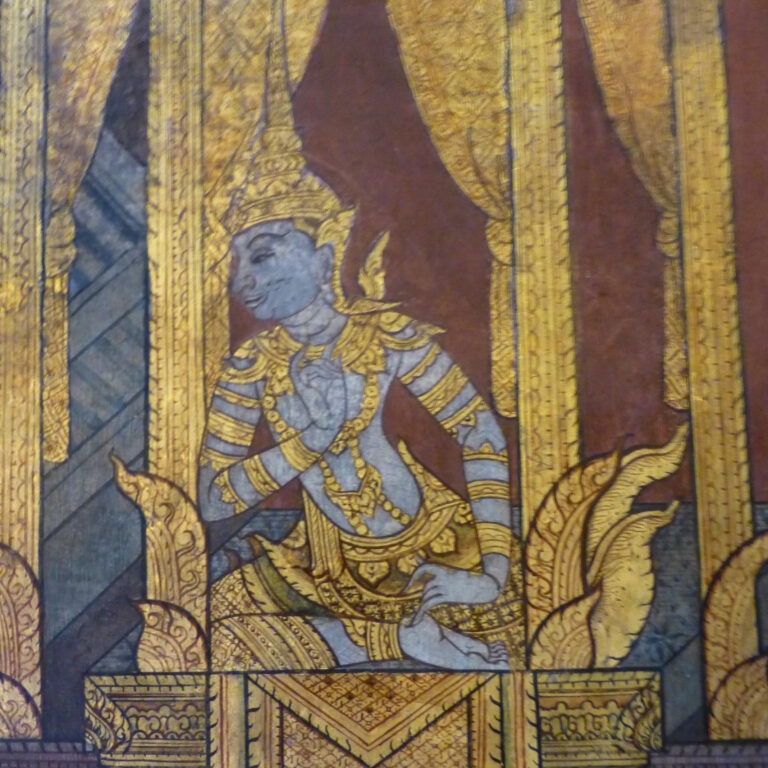Preface and Story
Khujjuttara was among the foremost female disciples of the Buddha who were lay followers. On one occasion, the Buddha told a group of mothers that they should encourage their daughters to become like Khujjuttara, explaining that she was “the standard and criterion” for his female lay disciples (Samyutta Nikaya 17.24; Bhikkhu Bodhi, translator, Connected Discourses of the Buddha: A Translation of the Samyutta Nikaya (2003: 689).
The story here tells how Khujjuttara came to be “best” among the Buddha’s female lay followers who “are very learned,” and how she came to hear and remember the whole Pali canon. Indeed, a text included in the Pali canon, the Itivuttaka, was first heard by Khujjuttara and she then recited it to others, including to Ananda, the Buddha’s personal attendant. In this respect, Khujjuttara is Ananda, who recited the Buddha’s teachings at the “First Council”so they would be preserved after the Buddha’s death. It is in Ananda’s voice that sermons (sutta) begin, “Thus have I heard” (evaṃ me sutaṃ), and the Itivuttaka opens in Khujjuttara’s voice in a very similar way, “So have I heard” (iti me sutaṃ).
Story
King Udena gave Queen Samavati eight pieces of money every day for her to get flowers and it became a daily routine that a female servant of the queen named Khujjuttara would go to the garden of Sumana and buy the flowers. One day when she came, the gardener said to her, “I have invited the Buddha to be my guest and I am going to honor him by offering flowers. Wait a bit, and offer food to the Buddha with me. Stay to listen to the Dharma and then you can go, taking whatever flowers are left.” Khujjuttara agreed, saying that it sounded good. Sumana made his offerings to the Buddha and the community of monks that came with him. He took the Buddha’s bowl so that the Buddha could pronounce words of thanksgiving and blessing. The Teacher began to speak about thanksgiving and blessing. As Khujjuttara was listening to the Buddha, she entered the stream that flows to freedom.
Khujjuttara usually kept four pieces of money for herself and bought flowers with the other four; but on that day she bought flowers with all of the money and brought them back. Queen Samavati said to her, “Dear, did the king give us twice as much money today to buy flowers?” “No, Madam.” “Then why so many flowers?” “On the other days I kept four pieces of money for myself and bought the flowers only with the other four.” “Why didn’t you keep the money today?” “Because now, after hearing the Buddha teach, I know what is right.”
Queen Samavati didn’t berate Khujjuttara.she didn’t say anything like, “Unfaithful servant, give back all of the money you’ve taken all this time.” Instead, she said, “Dear, help me to experience what you have experienced, help me drink what you have drank, help me taste that which is without death.”
When Khujjuttara replied, “Have a bath prepared for me,” the queen had her bathed with sixteen bowls of scented water. The Queen had her presented with two fine new cloths. She had Khujjuttara dressed in one cloth and had the other wrapped over one of Khujjuttara’s shoulders. The queen had a seat prepared for Khujjuttara and a fan brought for her to use.
Khujjuttara sat down in the seat prepared for her, took the beautiful fan in her hand, and addressed five hundred women who had gathered. She taught the Dharma to them just as she had heard it taught by the Buddha. As the women were listening to Khujjuttara, they all entered the stream that flows to freedom.
Then they honored Khujjuttara and said, “Mother, from now on, don’t do anything unsuitable, but be a mother and a teacher to us. Go back to the Buddha and whenever he teaches, listen to everything and come back and tell us what he said”
Khujjuttara did so and eventually she knew the whole canon by heart. The Buddha even said that Khujjuttara was the best among all his female disciples who are very learned and who are able to give Dharma talks themselves.
Translated from Pali for this website by Charles Hallisey.
